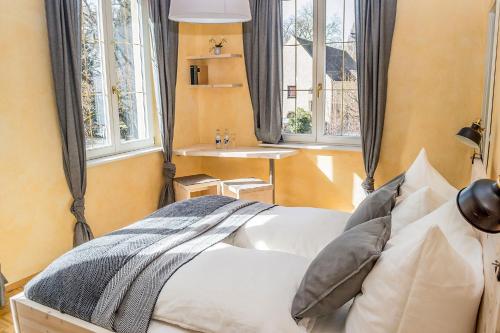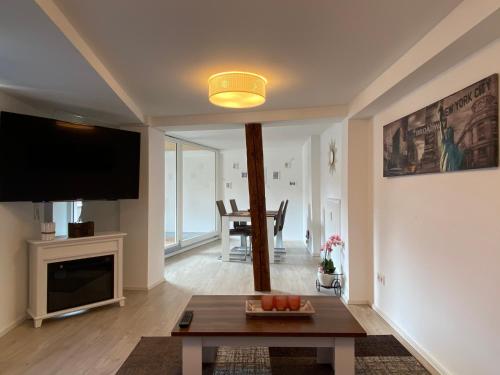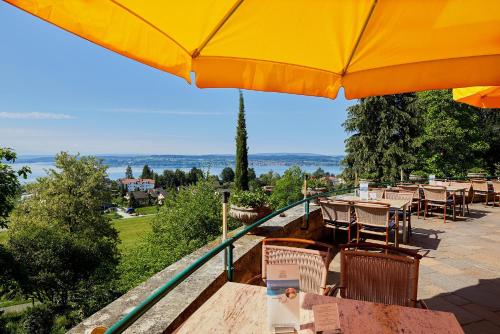Real estate agents always say that it’s about location, location, location. The ancient people who lived around the Alps region in central Europe 7000 years ago already knew that, though. And to understand the Pile Dwelling Museum, we need to start our story back then.
When it came to building their homes, it was all about location. Our prehistoric ancestors chose spots along the edges of lakes, rivers and wetlands and constructed wooden huts, elevated above the ground or water level on wooden piles.
This gave them multiple strategic advantages.
Firstly, there was the protection from wild animals because, even if these predators could cross the water or marshy ground, they couldn’t climb up to the houses.
Secondly, the inhabitants had easy access to the food supplies in the rich waters that flowed down from the mountains.
And, most importantly, the waterways on which they constructed their homes were also the main trade routes of the time so it was easy to do business with other people passing by in canoes.
Of course, the idea of ‘business’ is not what we imagine today.
What are pile dwellings?
The first of these pile dwellings appeared in about 5000BC, before even the most ancient of civilisations rose across the world. However, evidence from the sites show that the Neolithic people of this time were trading things like flint, shells and amber.
Over the coming millennia, this style of dwelling remained popular even as carts, pottery and textiles emerged. it wasn’t until about 800 BC that people stopped living in pile dwellings.
Even though houses elevated on wooden poles are found around the world (and are still quite common these days in parts of Asia, for example), these ones around the Alps were unusual for Europe. They were mainly concentrated around the edges of lakes, but also in bogs, along rivers, and in floodplains.
None of the original pile dwellings remain intact from this prehistoric time in Alpine Europe but the locations the people chose have provided one major benefit for us today – The waterlogged environments have protected the foundations and other relics that were left underwater when the inhabitants moved on.
For archaeologists, it’s an exceptional conservation of history from settlements that existed for thousands of years that give us an incredible insight into everything from the agricultural systems to metallurgy skills of these people.
We’ve even been able to learn about their everyday lives because of discoveries like pottery showing us what they ate and how they prepared the food.
Prehistoric Pile Dwellings around the Alps
There are 937 known locations of these prehistoric homes in the area around the Alps which stretch across what is today Austria, France, Germany, Italy, Slovenia and Switzerland. 111 of them have been protected as a World Heritage Site officially called the ‘Prehistoric Pile Dwellings around the Alps’.
Almost half of the pile dwellings are in Switzerland (56), followed by Italy (19), Germany (18), France (11), Austria (5), and Slovenia (2).
The sites themselves are a bit strange because, to the average visitor, there’s not much to see because the original dwellings are no longer standing. Any visible elements tend to be the foundations of houses, access paths, and palisades.
When archaeologists have been able to excavate into the ground or under the water, they’ve found tools, textiles, and even food. The layout of the communities has also become apparent and taught us more about how they lived as a society.
The earliest settlements were only used for between 5 to 20 years before they were rebuilt somewhere else. But, by the Late Bronze Age, the settlements tended to last for somewhere between 50 to 100 years.
I guess it’s also important to note that the pile dwellings weren’t lived in by a single society at any particular point, let alone over the course of thousands of years. A bit like Europe today, different types of people who lived different types of lives were still able to share a common architectural style.
It’s thought there were probably at least 30 cultures around the Alps that used these houses.
So, if you’re thinking of visiting the Prehistoric Pile Dwellings around the Alps World Heritage Site, how can you see something that’s more than just water with artefacts buried beneath?
Well, the best location to visit is the Pile Dwelling Museum in the German town of Unteruhldingen.
Visiting the Pile Dwelling Museum
On the edge of Lake Constance, in the town of Unteruhldingen, experts have reconstructed a small community of these ancient pile dwellings. It’s known as the Pile Dwelling Museum, or the Pfahlbau Museum, and you walk right throughout it all.
Although it is artificial in the sense that the structures are not original, everything has been put together exactly the way it would have been thousands of years ago. The museum is run by underwater archaeologists and cultural historians to ensure the accuracy of everything.
What is particularly interesting is the way the huts are displayed these days as interconnected. Although the construction is quite rudimentary, there is an advanced sense of community in the design.
The dwellings are built in clusters and are connected with elevated walkways. There is even a protective wall built in the water around one of the groups of buildings to create a small protected harbour.
The museum has also incorporated exhibitions, displays and reconstructions within the dwellings to help illustrate the life of the original inhabitants.
It is useful and informative but is a reminder that these structures are not strictly a historic site themselves, just representative of the ones that were once scattered all across this region and are now marked only by their underwater foundations.
Where is the Pfahlbau Pile Dwelling Museum?
The Pfahlbau Pile Dwelling Museum is located at:
Strandpromenade 6, D-88690, Unteruhldingen, Germany.
You can see it on a map here.
How do you get to the Pfahlbau Pile Dwelling Museum?
To get to the Pfahlbau Pile Dwelling Museum, catch the train to Überlingen and then take the bus number 7395 to Unteruhldingen which takes about 20 minutes, then follow the signs to walk the 10 minutes to the site.
When is the Pfahlbau Pile Dwelling Museum open?
The museum is open at the following times:
January – February: Guided tours Monday – Friday
1 March to 22 March: 10:00 – 17:30
23 March to 17 May: 10: – 17:30
18 May to end of September: 9:30 – 18:00
October to 3 November: Monday to Friday from 10:00 – 17:30
4 November to end of November: Guided tours Monday – Friday, and open Saturday – Sunday from 10:00 – 16:30
December: Guided tours Monday – Friday
How much is entry to the Pfahlbau Pile Dwelling Museum?
An entry ticket costs €12 for an adult.
Concession is €11.
And for children aged between 5 and 15, a ticket costs €8.
There’s another World Heritage Site in the region – Reichenau Island – which is also worth visiting when you’re here.
If you’re planning to see them both and spend a few days around Lake Constance, you’ll find more accommodation options in Konstanz. But the most convenient town to stay in to visit the Pile Dwelling Museum is Überlingen.
THE BEST ACCOMMODATION IN ÜBERLINGEN
There are a lot of lovely hotels in Überlingen, and you’ll also find quite a few self-contained apartments at affordable rates.
BUDGET

For an affordable and comfortable hotel, K-Hotel in the old town district has the best value.
HOTEL

With beautiful lake views, I would recommend the friendly family-run Hotel Restaurant Capri.
SELF-CONTAINED

This large one-bedroom apartment called Sky has a fully-equipped kitchen and is perfect if you want a bit of privacy.
LUXURY

When it comes to luxury in Überlingen, you can’t go past the wonderful Parkhotel St Leonhard, which even has a spa.
Time Travel Turtle was supported by DB Bahn, the German National Tourist Board and Youth Hostels in Germany but the opinions, over-written descriptions and bad jokes are his own.
Amazing to see that the people that existed before the printing press had a level of sophistication that few people give them credit for. Stupid cavepeople, they were not.
Very interesting post! Even though they’re not the original dwellings, it’s interesting to see what it was probably like and how life was. Thanks for sharing!
I would love live in such a dwelling. It’s ultra modern in all respects of Stylish Living c. 2016 !